Recently, Xiaogu Zhong and Jiancheng Wang have published another paper about their work on the origins of the soft X-ray excess from active galactic nuclei (2013, ApJ, 773, 23).
AGNs are very special extragalactic objects, in the sense that they are extremely bright. While apparently smaller than 1pc ( km), they can unleash up to
km), they can unleash up to  J of energy per second, far more than the total stellar luminosity of an ordinary galaxy (typically
J of energy per second, far more than the total stellar luminosity of an ordinary galaxy (typically  J/s). They are found in the nucleus areas of galaxies, and undergo intense activity, hence their name. They emit radiation distributed across the spectrum, including radio, IR, optical, X-ray and gamma-ray bands, among others. Their brightness is far beyond that which is attainable via nuclear reactions. Astronomers believe that such levels of brightness are attained by accretion of matter onto supermassive black holes, thereby releasing huge amounts of gravitational energy in the form of photons.
J/s). They are found in the nucleus areas of galaxies, and undergo intense activity, hence their name. They emit radiation distributed across the spectrum, including radio, IR, optical, X-ray and gamma-ray bands, among others. Their brightness is far beyond that which is attainable via nuclear reactions. Astronomers believe that such levels of brightness are attained by accretion of matter onto supermassive black holes, thereby releasing huge amounts of gravitational energy in the form of photons.
Soft X-ray emissions are an important component of AGN radiation, especially for Type I AGNs (those whose accretion disks are not viewed face-on), which have a huge amount of soft X-ray emission. Soft X-ray emission is typically much stronger than hard X-ray emission, forming a significant peak in the spectra known as the soft X-ray excess, the origins of which have always puzzled researchers in the field.

Fig. 1 AGN spectra exhibiting prominent soft X-ray excess
It is usually assumed that the soft X-ray excess arises from radiation from the accretion disk. However, according to classical accretion disk theory, an accretion disk which is able to radiate X-ray emission must have a central black hole of very small mass, as well as an accretion rate close to the Eddington rate, while observations of AGNs with prominent soft X-ray excesses do not support the existence of these characteristics. Furthermore, observations show that soft X-ray excesses are consistent with a Planck spectrum with a stable effective temperature of 0.1 to 0.2 keVs, an order of magnitude too hot for a typical accretion disk, which makes it difficult to explain such phenomena via a classical accretion disk. To address this problem, many alternative models have been proposed, including the absorption/reflection models, the slim disk model, the disk wind model, the thermal Compton model, and others. Yet all these models have fundamental difficulties in explaining the phenomena, and a different solution to the problem is desirable, if not required.
Magnetic fields exist in all celestial bodies. The paper takes magnetic fields into account, and proposes a new model, the magnetic reconnection model. The new model postulates that under the influence of differential rotation and turbulence of the accretion disk, magnetic fields inevitably undergo reconnection. Magnetic reconnection gives rise to shock waves and turbulence waves, which accelerate thermal electrons in the accretion disk into non- thermal electrons, which in turn energize the accretion disk photons via inverse Compton scattering, ultimately resulting in soft X-ray emission. The model was successfully fitted to the soft X-ray excess spectra of 25 AGNs, found that the energy conversion rate of this mechanism is rather low, and initiated the need for further studies on the physical nature of this process.